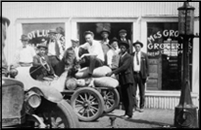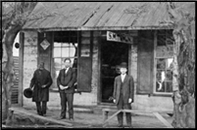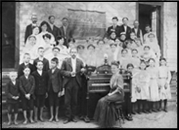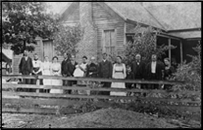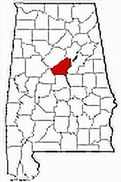|
"A County Older Than Its State"
Welcome to Shelby County, "The Heart of Dixie". We're
glad you're here taking a look at us, because we're proud of our county and like
to show it off. While visiting this site, should you have any questions,
comments, or need any assistance that I may help you with, please
email me.
Shelby County is the geographic center of the state of
Alabama. It is one of now seven counties comprising the Birmingham-Hoover
Metropolitan Area. The others are Jefferson, Blount, and St. Clair counties and
three new additions in June 2003 - Bibb, Chilton, and Walker. Shelby County is
bounded by Jefferson and St. Clair counties to the north, by Talladega and Coosa
counties to the east, and by Chilton and Bibb counties to the south and
southwest.
Shelby County was created by an act of the Alabama
Territorial General Assembly on 7 February 1818, from former Creek Indian
territory ceded in the Treaty of Fort Jackson on 9 August 1814. Prior to this
Creek Indian War of 1814 the land comprised today by the states of Alabama and
Mississippi was technically the domain of the southeastern Indian tribes
although an act of the United State government, in granting to the area the
status of a territory, created on 7 April 1798 the Mississippi Territory with
David Holmes Wyatt as governor. Shelby County when created became a part of the
Alabama Territory, having been created by an act of Congress in March 1817, and
was not granted statehood until 14 December 1819. Shelby County was formed out
of the northern portion of what was then Montgomery County having been created 6
December 1816 from a portion of Monroe County that was created 29 June 1815.
Originally, Shelby County was one of the largest counties in the state. However,
the state legislature soon began carving up the area to create other counties,
including St. Clair County, Jefferson, Talladega, and Chilton counties. The
marker for the geographic center for the state of Alabama can be found on the
steps of Main Hall at the University of
Montevallo. The actual geographic center, however, is said to be located
in the Richardson-Randall Cemetery, about 2 miles east of Montevallo.
The county was named for Isaac Shelby, a hero of the
King's Mountain Battle during the Revolutionary War. Also, he was the first
governor of the state of Kentucky, and had refused election to a second term as
governor in order to fight the Indian wars. The first courthouse was fashioned
of logs, and was located at Shelbyville, long since deserted, however, known
to have been located within the modern-day city of Pelham. It was selected as
the county seat in 1820 and the county's first courthouse was built by Thomas
Amis Rogers, Alabama's first Secretary of State [he died 22 September 1821],
who, along with his neighbor George Phillips, represented the county in the
state's first Constitutional Convention in 1819. Judge Thomas W. Smith was the
first judge to preside in it. The Shelbyville courthouse, built at a cost of
$53, was used until 1826, when the decision was made to move the courthouse and
the county seat.
In 1826 the location of the courthouse was moved to an
old school building in Columbia, located in the central part of Shelby County.
However, an act of the Legislature changed its name to Columbiana on 13 January
1832, and the county seat was then permanently located at Columbiana. (Cahawba Democrat, dated December 30, 1837,
"List of the Acts of the General Assembly of the State of Alabama,
passed at the session of 1837 ... To incorporate the town of Columbiana, in the County of Shelby.") The
"Petition to Incorporate Columbiana"; is found in Will Book "K" dated 10 August
1853 and was signed by A.A. Sterrett, Wm. M. Allen, B.O. Nabors, N.B. Mardis,
R.H. Brasher, John T. McComic, A.M. Elliott, E.G. Lawley, J.A. Teague, Samuel
Leeper, S. Brasher, H.V. Nabors, D.W. Caldwell, J.L. Wilson, D.N. McClanahan,
A.J. Donus, A. Parnell, Jos. Roper, Jno. Baker, and L.F. Elliott. In 1854, the
decision was made to build another courthouse, which is today referred to as the
"old courthouse", and the Shelby County Historical Society and Shelby County
Museum & Archives moved into it in 1982 and are still there today. Construction
began on the current stone courthouse in 1905 at a then-price of $300,000. [The Montgomery Advertiser,
dated September 10, 1905, "Columbiana, Sept. 9 - The work on the new Court
House, by way of excavating and getting a good foundation, is progressing
rapidly. The rock crusher has been called into requisition, and the rock is
being fast converted into proper form for laying the foundation."] The contract
was signed 11 September 1905 with B.C. Bynum Construction Company, contractors
of Montgomery, Alabama, and "the plans, specifications and addenda" be prepared
by Bruce Architectual Company of Birmingham, Alabama. The cornerstone ceremony
was held 05 April 1906. An addition was completed in 1954 with E.C. Coston,
Contractor and the Architect was Martin J. Lide. The Open House at the "New
Court House Addition" was held Sunday, 9 January 1955. It received a
multi-million dollar renovation in the early 1990's. On 04 March 2006 the
contents were removed from the cornerstone and placed on display at the Shelby
County Museum & Archives. The "100-year celebration and cornerstone ceremony"
was held 24 June 2006.
The first authentic records regarding Shelby County date
from 1820 when early white settlers held their lands by virtue of what was known
as Squatter Sovereignty, and titles to their holdings were not granted by the
government until 1821. The fear of an attack by marauding bands of Indians
caused the settlers to be on the alert lest their possessions be stolen or
burned. However, when government Land Offices were opened, farmers and others
who had established themselves on choice plots of ground rushed in to apply for
and receive title.
Most of the first settlers came from South Carolina,
Tennessee, and Kentucky and returned to this region after the victorious Battle
of Horseshoe Bend in 1814. They brought their families and their household
goods, traveling chiefly by pack horse, to remain in this section of Alabama.
The first settlements in the area were at Montevallo, then known as
Wilson's Hill,
Harpersville,
Wilsonville, and
Shelbyville. As indicated in the 1820 Shelby County census records, two
years after it was created, the county contained 2,492 people; 2,044 whites and
448 Negroes. Shelby County has experienced a 210 percent increase in population
between 1970 and 1990. In 1992, the population was 107,261 in a land area of 646
square miles, an average of 166 people per square mile. The U.S. Bureau of
Census lists Shelby County's 1998 population as 140,715, up from 135,752 in
1997, a 3.7 percent increase. According to the Census Bureau, Shelby County's
population increased some 42 percent between 1990 and 1998 and is now the sixth
largest county in Alabama. It is the fastest growing county in Alabama and among
the fastest in the United States.
As indicated in the Shelby Guide, dated Tuesday,
2 April 1872, "Not only is the coal and the iron of Alabama superior to any
found elsewhere in the United States, but the lime also. In Shelby County are
very extensive lime works...."
The year 1923 will always be an important year in the
history of Shelby County. The county was so deeply in debt that only the most
optimistic could have found any sign that the debt would ever be paid. The
treasury was empty; there was no money to carry on ordinary operating expenses.
The situation could hardly have been worse. However, as indicated in the
Shelby County Reporter-Democrat, dated Thursday, 25 June 1953, " July
First Will See County Debt Free" ... and dated Thursday, 11 June 1953, "July 1,
1953 will be an important date in the history of Shelby County. On that day the
Board of Revenue and Control will pay the last dollar of the county's
indebtedness. For the first time in many long years, maybe the first time since
Shelby County was organized, there will be no debt. Shelby County will be debt
free.
"SHELBY COUNTY IS WINGING ITS WAY TO VICTORY"
 The above Flying Fortress was purchased by funds raised in the 4th War Loan Drive
(in 1944)
The above Flying Fortress was purchased by funds raised in the 4th War Loan Drive
(in 1944)
- by Shelby County citizens -
This is the Boering Flying Fortress, the famous high-altitude,
day-light
precision bomber which is operating in war theatres throughout the world.
The Boering Fortress
has four engines and a wing span of approximately
104 feet. It has a top speed in excess of 200 miles an hour,
carries a
bomb load up to ten tons, has a service ceiling above 40,000 feet, is
heavily armed with 13 50-calibre
machine guns, and is capable of
operating over a long range. The flying Fortress was designated and
developed
by the Boering Aircraft Company, with plants located in Seattle
and Renton, Wash., Wichita, Kans., amd Vamcouver, B.C.
(W.A. Cone,
connected with the Works Progress Administration, was the construction supervisor of the
Columbiaia Airport built in 1939.)
ENJOY THESE YOUTUBE VIDEOS:
Walking & Biking in Shelby County Alabama by Leadership Shelby County Class of 2004
All In A Day's Drive ... in Shelby County Alabama
Shelby County offers a variety of museums that cater to
the interests of genealogists, world travelers, history buffs, railroad
aficionados, or others who are simply interested in seeing and learning
something new. The Shelby County Museum & Archives and
Shelby County Historical Society, Inc. are
located in the old courthouse in Columbiana. The building contains much more
than old records, so those simply wanting to learn more about the county's
history will find many artifacts donated by Shelby County families, as well as a
collection of historical books.
Karl C. Harrison Museum of George
Washington located in the Mildred B. Harrison Regional Library in
Columbiana houses the largest collection of George and Martha (Custis)
Washington Memorabilia outside of Mount Vernon. Travel back to the railroad age
at the Heart of Dixie Railroad Museum
in Calera. The museum contains a restored depot and railroad cars that sit
outside the depot. A train, complete with snack and gift shop car, passenger
cars from 1910-1950, engine, and caboose takes passengers down the rails through
the forest. You will want to attend the annual "Shelby Iron Works Festival" in
the Historic Shelby Iron Works Park, located along Shelby County Alabama Highway 42 in
Shelby, Alabama. The Aldrich Coal Mine Museum housed in the
Company Store of the former Montevallo Coal Mining Company, and the beautiful
Farrington Hall, built by Mr. and Mrs. William Farrington Aldrich,
houses many Aldrich items from its past and an enormous number of pictures and
artifacts. In early 2012 two museums added in Shelby County were
Kenneth R. Penhale City of Helena Museum and City of Chelsea
Historical Museum. CLICK HERE to view the first Chelsea Jr. High School "Chelsea Chimes" 1955 Yearbook.
Oak Mountain State Park is the largest state park in Alabama. It is
located in Pelham, on the southernmost part of the Appalachian Mountain chain. A new mountain biking trail has made its way to Oak Mountain State Park and is ready to enjoy.
On Saturday, January 7, 2023 the official ribbon cutting was held for the new mountain bike trail named “Tails.”
One of the most famous attractions in Shelby County,
dedicated Tuesday, 30 November 1999, is
The American Village, located on Highway 119 just north of
Montevallo. It is Alabama's nationally-pioneering citizenship education center
and historical park where visitors learn about the foundations of our Nation and
the application of good citizenship in everyday life.
I personally find this article
Local Haunts: the chilling history of Shelby County
in the Shelby County Reporter dated 3 November 2021 to be very
interesting. As stated by Staff Writer Michelle Love, "The haunted rumors of a
historic Shelby County careen across its 808 square miles, and while none of the
tales are proven, they all at least date back to historical moments in the
county, providing a dive into what shaped the county." This collaborates with
some of the ghost stories that are told in the book "The Heritage of Shelby
County, Alabama" published in 1999, pages 127-130.
For further information concerning Shelby County Alabama
visit Shelby County Alabama
website and the Shelby County ALGenWeb
website. To view more of Shelby County's History - "All In A Day's Drive" - Click Here.
On 15 July 1983 the first Shelby County "satellite
license office" opened in Pelham and was located in the Pelham Plaza Shopping
Center on U.S. Highway 31 (a.k.a. Pelham Parkway) and then moved into the
"first" Shelby County Services Building located at 1000 County Services Drive in
Pelham. Shortly after its opening the building was named James "Alfred" Jones
County Services Building as announced in the Shelby County Reporter dated
11 December 2007. It was named in tribute to his legacy of service as a
long-time county employee. On 17 July 2006 the second "satellite license
office" opened in Inverness and was located at 310 Inverness Corners. An
additional Shelby County Services Building with a dedication ceremony on
15 November 2021 and was opened to the public starting 16 November 2021. It
was named in honor of Shelby County's previous county manager Alex A. Dudchock.
The building is located at 19220 U.S. 280. The new county license office
replaced the Inverness license office, along with the Greystone Shelby County
Sheriff's Office substation and Westover water services office.
CLICK HERE for additional information.
Ya'll come back!
VIEW THE SHELBY COUNTY ALABAMA
COURTHOUSE TIME CAPSULE CENTENNIAL CELEBRATION
1906-2006

Copyright - Bobby Joe Seales - 2000
|


